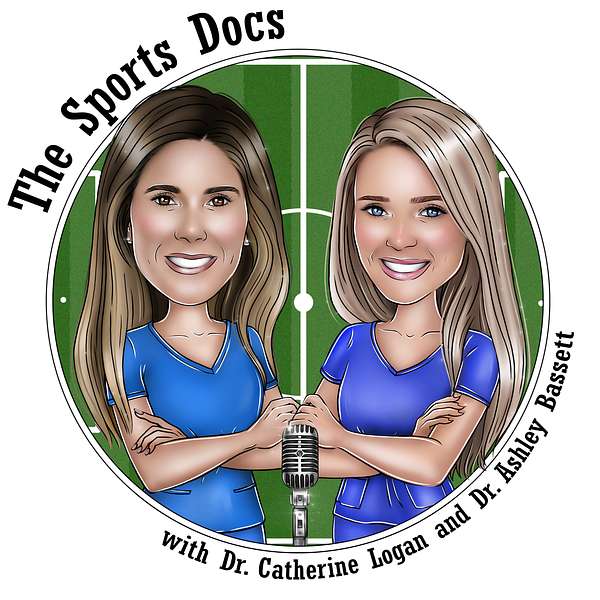
The Sports Docs Podcast
Sports medicine is a constantly evolving field, with hundreds of new articles published each month on the topic. This ever-growing wealth of information can make it challenging to stay updated on the newest approaches and techniques, and to know which data should actually change your practice. Join orthopedic surgeons, Dr. Catherine Logan and Dr. Ashley Bassett, as they chat about the most recent developments in sports medicine and dissect through all the noise.
On each episode of The Sports Docs podcast, the hosts will tackle a specific injury – from ACL tears to shoulder instability – and review the top research from various high-impact journals that month, including The American Journal of Sports Medicine, Arthroscopy: The Journal of Arthroscopic and Related Surgery, Sports Health, Journal of Shoulder and Elbow Surgeons, and more. The Sports Docs will also be joined by experts in the field of sports medicine – orthopedic surgeons, nonoperative sports medicine specialists, athletes, physical therapists, athletic trainers and others – to provide a fresh and well-rounded perspective based on their unique experiences.
The Sports Docs – Dr. Logan & Dr. Bassett – are friends & former co-residents from the Harvard Combined Orthopaedic Residency Program, who went onto esteemed sports medicine fellowships at The Steadman Clinic and The Rothman Institute, respectively. Dr. Logan practices in Denver, CO, and serves as Team Physician for Men's USA Lacrosse & as a Team Physician for U.S. Ski & Snowboard. Dr. Bassett is the director of the Women’s Sports Medicine Center at the Orthopedic Institute of New Jersey and practices across northern NJ, primarily in Morris and Sussex Counties.
Together, they will bring monthly conversations on how to care for athletes of all ages and levels of play, with a healthy mix of cutting-edge science and real-world application.
The Sports Docs Podcast
18. Dr. Anand Murthi: Management of Rotator Cuff Tears - Part II
We’re going to continue our discussion with Dr. Anand Murthi and focus on the surgical treatment options for irreparable rotator cuff tears.
We’ll start with the article titled “Minimum 2-year Clinical Outcomes After Superior Capsule Reconstruction Compared With Reverse Total Shoulder Arthroplasty for the Treatment of Irreparable Posterosuperior Rotator Cuff Tears in Patients Younger Than 70 Years” from December 2020 issue of JSES. Peter Millett and colleagues at the Steadman Clinic in Vail reported significant improvements in clinical outcome scores, high patient satisfaction and high rates of return to sport at 2-years post-op, with no significant differences between the two procedures. The authors concluded that SCR is a reliable alternative to arthroplasty for younger patients with irreparable cuff tears in the absence of glenohumeral arthritis. SCR has the benefit of being an arthroscopic procedure that preserves native anatomy, allowing for easier revision surgery in the future.
Then, from the June 2019 issue of JBJS, we review the publication “Biomechanics of a Biodegradable Subacromial Balloon Spacer for Irreparable Superior Rotator Cuff Tears.” Authored by our guest Anand Murthi and his team at MedStar, this laboratory study found that placement of a subacromial balloon spacer in the setting of a massive irreparable supraspinatus tear restored glenohumeral contact pressures and the center of glenohumeral contact to that of an intact rotator cuff. Additionally, placement of the balloon increased the deltoid load and lowered the humeral head, increasing the acromiohumeral interval and decreasing subacromial contact pressures. The authors concluded that the subacromial balloon spacer may help overcome the biomechanical effects of a deficient cuff and thereby postpone the need for arthroplasty.
Lastly, we finish up with a systematic review from the July 2020 issue of JSES titled “The Lower Trapezius Transfer: A Systematic Review of Biomechanical Data, Techniques and Clinical Outcomes.” Two tendon transfers have been described for treatment of irreparable posterosuperior rotator cuff tears: latissimus dorsi and lower trapezius. Compared to traditional latissimus dorsi transfer, the lower trap transfer is more anatomic and better restores shoulder abduction and external rotation. One drawback of the lower trap transfer highlighted by this paper is limited tendon excursion requiring the addition of a graft. In the setting of a cuff tear, direct transfer to the tuberosity without graft extension increases muscle tendon strain and risk of failure, and therefore is not recommended. Lower trap transfer can be performed through an open or arthroscopically-assisted approach while latissimus dorsi transfer can also be performed entirely arthroscopically.